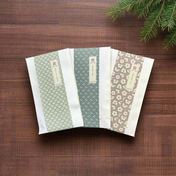Kakishibu is a natural dye derived from juicing unripe persimmons. The juice is then fermented to create the final product, a tannin which can be used in many domestic situations. This dye is of great cultural value to the Japanese people and has been used throughout much of Japan’s extensive history for many items including sake bags, kimono, and paper.

Unripe persimmons make the best tannin. The fruit is crushed and fermented for about a week.
Photo credit: https://tetsukuri.wordpress.com
The dye offers a beautifully subtle yet rustic appeal to natural fibers which is very familiar to the Japanese eye. Originally used in ancient China and Japan as a herbal cure for stroke, persimmon tannin has also been said to be helpful for recovering after intoxication.

Fabric dries in the sun after being hand dyed using persimmon tannin dye. This fabric can be used to create a variety of goods including purses, tenugui, and clothing.
Photo from Instagram: yokoyamamasami
The persimmon tannin also prevents bacteria making it an ideal dye for socks and undergarments. The natural dye is also perfect for individuals with chemical sensitivities.

A handcraft artist funnels kakishibu dye into a glass bottle. Although the dye is dark, almost black at times, it will produce a pink color when applied to natural materials.
Photo from Instagram: @noborori
A Traditional Color
Persimmon fruit, called “kaki” in Japanese, are native to almost all of Japan. The tannin has been used to make paper, umbrellas, and wooden crafts in Japan for thousands of years.

An Edo period fireman’s jacket dyed using kakishibu. Kakishibu made the garment more durable and safe for firefighters at the time.
Photo credit: The Benaki Museum
The dye prevents bacteria growth and also works to harden whatever material it is applied to. Kakishibu can make natural fibers, such as cloth, washi (Japanese style paper) and wood, more water resistant.

Kakishibu has been used to strengthen and color sake bags. These bags are used by sake breweries in the pressing process.
Photo credit: http://www.nada-ken.com/
Historically, kakishibu has been combined with indigo dyes to create a beautiful, natural contract of designs on fabric. As a result, these carefully designed fabrics became expensive and sought after luxuries.

Kakishibu dye gives natural fibers a water resistant finish and a beautiful natural color.
Photo by: kimono.no-iroha.com
In the past, persimmon tannin was used to coat fishing net as it prevents corrosion of the fibers. The natural properties also prevent mold growth and insect infestation. They could also be reapplied every year in order to strengthen the fabric and deepen the color. When applied year after year, these fabrics began to resemble a brown leather. Some artists have recycled these fishing nets to create rare yarn (pictured below).

Traditional weaving goods including a spool called a kiwaku and yarn made from recycled fishing nets which had been soaked in kakishibu.
Photo from instagram: alejandra_pons
An Artistic Touch
There’s no denying that kakishibu has a distinct aesthetic. This color is easily recognizable to those familiar with its rustic hue.

Perfect for adding color and durability to natural fabrics, Kakishibu has become more popular among fashion designers.
Photo from Instrgram: @ptworksdesign
Recently, high end fashion designers have taken advantage of this versatile and subtle dye. However, because persimmon tannin takes two to five years to properly age, it is not for the impatient. In true Japanese fashion, kakishibu is a slow art that possesses an appealing imperfection.

Kimono dyed with persimmon tannin on display in a museum in Japan. This traditional color goes back far in Japanese history.
Photo from Instagram: @tjcarlone

Kakishibu is the perfect natural dye for handcraft projects. Take a glimpse at the kakishibu used in this artist’s studio.
Photo from Instagram: ptworksdesign
Wabisabi
The Japanese idea of wabi-sabi has no direct English translation. However, the concept can be described as a an artistic mindset which finds beauty in natural imperfection.

The dye can be used on all types of materials including book covers and paper.
Photo from Instagram: @susantomi
Art may be broken, incomplete, or distorted over time. All of these minor imperfections work together to create beauty. Most noteworthy is that the wab-isabi aesthetic celebrates simplicity, asymmetry, and roughness as beautiful qualities. Kakishibu falls perfectly into this idea of wabi-sabi beauty.

Persimmon tanin creates the perfect color for fall fashion.
Photo from instagram: @yokoyamamasami
Its color may change overtime, the dye may never produce the same shade twice, but in these imperfections there is an irreplaceable beauty.

Persimmon tannin has the ability to create a wide variety of colors and shades. Fabric can be re-dyed to deep the color.
Photo from Instagram @den_nibiiro
The post Kakishibu: Natural Color for a Natural Life appeared first on YUNOMI.


